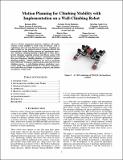Motion Planning for Climbing Mobility with Implementation on a Wall-Climbing Robot
Author(s)
Albee, Keenan Eugene Sumner; Espinoza, Antonio Teran; Andreyeva, Kristina; Werner, Nathan; Chen, Howei; Sarvary, Tamas; ... Show more Show less
Downloadieee_aero_19_albee_et_al.pdf (11.02Mb)
Open Access Policy
Open Access Policy
Creative Commons Attribution-Noncommercial-Share Alike
Terms of use
Metadata
Show full item recordAbstract
Future autonomous planetary explorers will require extreme terrain mobility to reach areas of interest, such as walled lunar pits and steep Martian rock layers. Climbing mobility systems are one proposed answer, requiring efficient and kinematically feasible motion planning for autonomous operation. Similarly, climbing planning is applicable to other micro-gravity situations requiring constant end effector contact with discrete handholds. This paper proposes a planning framework that poses kinematic climbing planning as a discrete optimal planning problem. Motion primitives are used to encourage large robot body workspaces and beneficial connections between climbing stances. A wall-climbing planner simulation is presented, along with implementation on a hardware demonstration testbed that successfully recognized, navigated, and climbed an arbitrary vertical wall.
Date issued
2019-06Department
Massachusetts Institute of Technology. Space Systems LaboratoryJournal
2019 IEEE Aerospace Conference
Publisher
Institute of Electrical and Electronics Engineers (IEEE)
Citation
Albee, Keenan et al. "Motion Planning for Climbing Mobility with Implementation on a Wall-Climbing Robot." 2019 IEEE Aerospace Conference, March 2019, Big Sky, Montana, USA, Institute of Electrical and Electronics Engineers, June 2019. © 2019 IEEE
Version: Author's final manuscript
ISBN
978-1-5386-6854-2